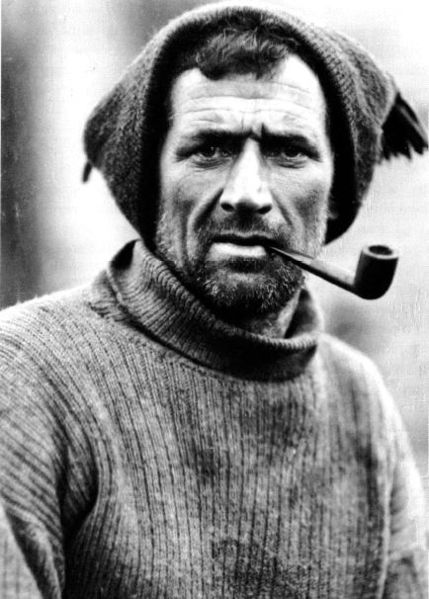Thomas “Tom” Crean (1877– 1938)
 Thomas “Tom” Crean, nicknamed the “Irish Giant”, was an Irish seaman and Antarctic explorer. He was a member of three major expeditions to Antarctica during the Heroic Age of Antarctic Exploration, including Captain Scott’s 1911–13 Terra Nova Expedition, during which he made a 35 mile (56 km) solo walk across the Ross Ice Shelf to save the life of Edward Evans. Crean’s contributions to these expeditions sealed his reputation as a tough and remarkable polar explorer, and earned him a total of three Polar medals.
Thomas “Tom” Crean, nicknamed the “Irish Giant”, was an Irish seaman and Antarctic explorer. He was a member of three major expeditions to Antarctica during the Heroic Age of Antarctic Exploration, including Captain Scott’s 1911–13 Terra Nova Expedition, during which he made a 35 mile (56 km) solo walk across the Ross Ice Shelf to save the life of Edward Evans. Crean’s contributions to these expeditions sealed his reputation as a tough and remarkable polar explorer, and earned him a total of three Polar medals.
1901-1904 ‘Discovery Expedition’
Crean enlisted in the Royal Navy at the age of 15. In 1901 he volunteered to join Scott’s 1901–04 Expedition to Antarctica on Discovery, thus beginning his exploring career. Discovery arrived in McMurdo Sound on 8 February 1902 and the men established a base from which they would launch scientific and exploratory sledging journeys. Crean was one of the most consistent man-haulers, undertaking three sledging trips across the Ross Ice Shelf, then known as the “Great Ice Barrier”, and logging 149 days over the course of the expedition. It was at this time that he formed close friendships with William Lashly and Edgar Evans, who would also establish themselves as seasoned polar explorers.
1910-1913 ‘Terra Nova Expedition’
Crean was among the first people Scott recruited for the Terra Nova Expedition. His first major contribution to the expedition was as part of the 13-man party who laid “One Ton Depot” 130 statute miles (210 km) from Hut Point. On the return journey, Crean, Apsley Cherry-Garrard and Lieutenant Henry “Birdie” Bowers camped on unstable sea ice, which broke up during the night, leaving the men adrift and separated from their sledges. Crean probably saved the men’s lives by leaping from floe to floe until he reached the Barrier edge and was able to get help.
Crean departed with Scott in November 1911 for the attempt on the South Pole. Crean and William Lashly, and Lieutenant Edward Evans, formed the final support party which accompanied Scott and his team to 87°32’S, 168 statute miles (270 km) from the Pole. Here, on 4 January 1912, Crean’s party was ordered to return to base. The three began their 700-statute-mile (1,100 km) journey back to Hut Point but soon lost the trail. Faced with a long detour around a large icefall, and with food supplies short, they made the decision to slide on their sledge, uncontrolled, 2,000 feet (600 m) down the icefall. Evans later wrote: “How we ever escaped entirely uninjured is beyond me to explain”. Evans began to display symptoms of scurvy and collapsed when they reached One Ton Depot on February 11. Crean and Lashly hauled Evans on the sledge, arriving at Corner Camp a week later, still 35 statute miles (56 km) from Hut Point. With only one or two days’ food rations left, but still four or five days’ man-hauling to do, they decided that Crean should go on alone to fetch help. Crean walked the distance to Hut Point in 18 hours, with only a little chocolate and three biscuits to sustain him, and without a tent or survival equipment. He arrived in a state of collapse, just ahead of a fierce blizzard, which probably would have killed him. The rescue party was delayed by the storm, but Lashly and Evans were both brought to base camp alive. Crean modestly played down the significance of his feat of endurance.
In November 1912, Crean was one of the 11-man search party that found the remains of the polar party. On 12 November they spotted a cairn of snow, which proved to be a tent against which the drift had piled up. It contained the bodies of Scott, Wilson, and Bowers.
Imperial Trans-Antarctic Expedition (1914-17)
Crean’s third and final Antarctic venture was the Imperial Trans-Antarctic Expedition on Endurance (1914-17) led by Ernest Shackleton, in which he served as second officer. After Endurance became beset in the pack ice and sank, he was a participant in a dramatic series of events including months spent drifting on the ice, a journey in lifeboats to Elephant Island, and an open boat journey of 800 nautical miles (1,500 km) from Elephant Island to South Georgia. Shackleton, in his later account of the journey, recalled Crean’s tuneless singing at the tiller: “He always sang when he was steering, and nobody ever discovered what the song was … but somehow it was cheerful”. Upon reaching South Georgia, Crean was one of the party of three which undertook the first land crossing of the island, without maps or proper mountaineering equipment, to get aid.
Crean’s contributions to these expeditions sealed his reputation as a tough and remarkable polar explorer, and earned him a total of three Polar medals. Despite this, he remained an extremely modest man throughout his life. When he returned to Kerry, he put all of his medals away and never again spoke about his experiences in the Antarctic.
Crean returned to Britain in November 1916 and resumed his naval duties. When he retired in 1920, Crean and his wife Ellen opened a small public house in Annascaul, County Kerry, which he called the South Pole Inn. He lived there quietly and unobtrusively until his death in 1938.





